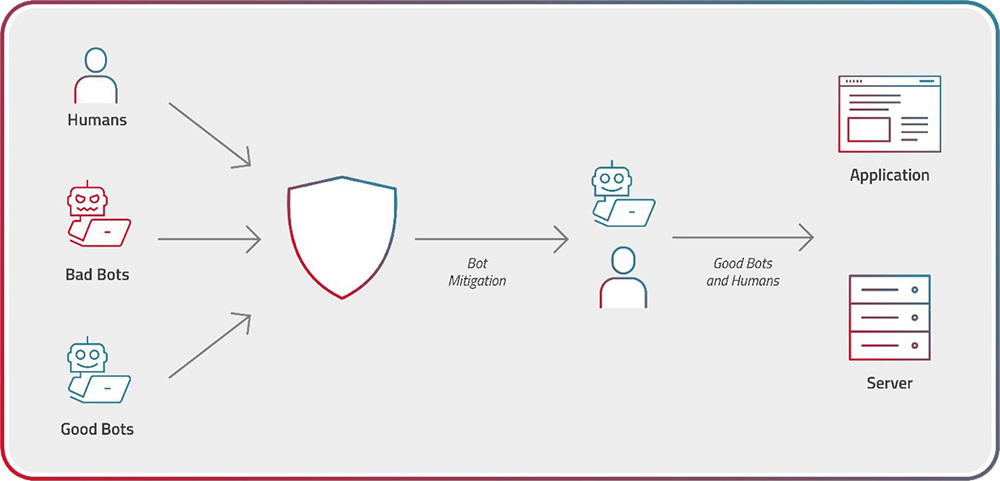
Bot management is, at its core, the process of identifying, categorizing, and managing bot traffic on a website or application. It involves blocking undesired or malicious “bad” bots while still allowing useful bots to access web properties. Bot management accomplishes this by detecting bot activity, differentiating between desirable and undesirable bot behavior, and identifying the sources of the undesirable activity.
Bad bots can cause massive problems for web properties. Too much bot traffic can put a heavy load on web servers, slowing or denying service to legitimate users (DDoS attacks are an extreme version of this scenario). Bad bots can also scrape or download content from a website, steal user credentials, take over user accounts, rapidly post spam content, and perform various other kinds of attacks. Bot management is necessary to prevent these performance and security impacts on websites, applications, and APIs, by leveraging a range of security, machine learning, and web development technologies to accurately detect bots and block malicious activity while allowing legitimate bots to operate uninterrupted.
The Importance of Bot Management
A bot manager is crucial in ensuring specialized, enterprise-grade defense against sophisticated bots that carry out malicious attacks against websites, applications, and APIs operated by every type of industry and organization. A solution such as Radware Bot Manager safeguards digital touchpoints against automated threats by using behavioral modeling, collective bot intelligence, and fingerprinting to protect against critical risks like account takeover, DDoS, ad and payment fraud, web scraping, and other types of attacks.
The impact of bots on businesses can be both good and bad. Good bots, such as search engine crawlers, can help direct traffic to a website and improve its visibility. However, malicious bots can cause harm by stealing data, committing fraud, scraping protected content, and overloading servers, affecting the user experience.
Effective bot management is necessary to protect digital assets and maintain a secure environment. By filtering bot traffic and allowing only useful bots to access web properties while blocking malicious or unwanted bots, businesses and other organizations can prevent damaging performance and security impacts. Organizations can choose to handle bots through specific mitigation policies that best suit their specific needs.
Good Bots vs. Bad Bots
Good bots and bad bots have different roles and objectives. Good bots are designed to help businesses and users and can improve customer experiences. For example, search engine bots crawl the web to index content so that it can show up in searches, or help consumers find the best prices. On the other hand, bad bots are used to execute malicious objectives, and can significantly harm organizations and users by stealing data, taking over user accounts, submitting junk data through online forms, and performing other malicious activities.
Typically, good bots have two main criteria that make them distinguishable from bad bots: they do not hide their identity as bots and they follow rules and policies laid out in a website’s “robots.txt” file. They are typically deployed by legitimate, well-known companies that provide useful services. Bad bots neither obey webmasters’ rules for bots, nor do they identify themselves clearly as good bots do—though they are known to try to pass themselves off as legitimate bots.
The general process of bot management involves detection, analysis, response, and monitoring. There are three main approaches to bot management: Static, Challenge-based, and Behavioral.
Static approach uses static analysis tools to identify web requests and header information that active and known malicious bots are reported to use. This technique is effective in detecting bad bots that are already recorded and known.
Challenge-based approach uses active challenges or tests that are difficult or impossible for bots to perform.
Behavioral approach evaluates the activity of potential users and matches that activity against known patterns to verify user identity.
A solution like Radware Bot Manager uses behavioral modeling, collective bot intelligence, and fingerprinting to accurately detect and mitigate bot threats. With a range of mitigation options, including a unique Crypto Challenge, it allows legitimate users to browse without CAPTCHAs while still thwarting bot attacks. Radware Bot Manager’s comprehensive protection includes secure identity and device and app attestation for native iOS and Android mobile applications to ensure accurate and effective protection against identity spoofing, identity tampering, and replay attacks. It also prevents mobile emulators, modified applications, and modified mobile operating systems from accessing resources.
An effective bot management solution has several key components: detection, identification, response, and monitoring:
- Detection: Involves identifying bot traffic on a website or application. This can be done through various methods such as analyzing web requests, header information, and user behavior.
- Identification: The categorization of the detected bot traffic as either good or bad can be done through techniques such as machine learning, behavioral analysis, and fingerprinting.
- Response: The process of taking appropriate action based on the identified bot traffic can include blocking malicious bots while still allowing useful bots to access web properties.
- Monitoring: The continuous tracking of bot activity to ensure that the bot management solution is effectively protecting against malicious bots and allowing useful bots to operate uninterrupted.
These components work together to provide comprehensive protection against automated threats. By accurately detecting and identifying bot traffic, responding appropriately to block malicious bots while allowing useful bots to operate, and continuously monitoring bot activity, an effective bot management solution can protect digital assets and maintain a secure environment for businesses.
Detection and Identification
Bot management solutions like Radware Bot Manager use advanced technologies and techniques to accurately detect and identify bots. These include behavioral analysis, IP reputation, device fingerprinting, and collective bot intelligence.
Behavioral analysis involves evaluating the activity of potential users and matching that activity against known patterns to verify user identity. This can include analyzing mouse movements, scrolling behavior, and other user interactions to distinguish between human and bot behavior.
IP reputation involves checking the reputation of the IP addresses associated with web requests to determine if they are associated with known malicious bots. This can be done by checking against blacklists of known bad IP addresses or by analyzing the history of activity associated with an IP address.
Device fingerprinting involves collecting information about the device being used to access a web property to determine if it is associated with known malicious bots. This can include information such as the device’s operating system, browser type, and installed fonts.
Collective bot intelligence involves sharing information about known malicious bots across a network of protected web properties to improve the accuracy of bot detection and identification.
Leveraging these advanced technologies and techniques allows bot management solutions like Radware Bot Manager to accurately detect and identify bots to provide comprehensive protection against automated threats.
Response and Monitoring
Once bot management solutions like Radware Bot Manager have detected and identified bots, they take appropriate actions to respond to the bot traffic. These actions can include blocking malicious bots, rate limiting bot traffic, or serving alternate content to bots.
Blocking involves preventing malicious bots from accessing a web property. This can be done by blocking the IP addresses associated with the bots or by using other techniques such as JavaScript challenges or CAPTCHAs.
Rate limiting involves limiting the rate at which bots can access a web property. This can help prevent performance impacts on the site by ensuring that bot traffic does not overload the servers.
Serving alternate content to bots involves serving different content to bots than to human users. This can be used to prevent bots from scraping protected content or to serve them content that is specifically designed for bots. Radware Bot Manager has a “Feed Fake Data” response option that helps e-commerce websites conceal their real pricing from scraper bots deployed by competitors.
Continuous monitoring and updating of bot management solutions is important to ensure that they remain effective against evolving bot threats. As new malicious bots are developed and deployed, bot management solutions must be updated to accurately detect and identify them. By continuously monitoring bot activity and updating their detection and identification techniques, bot management solutions can provide ongoing protection against automated threats.
Radware Bot Manager provides real-time bot protection for web applications, mobile apps, and APIs. It safeguards against automated threats by using behavioral modeling, collective bot intelligence, and fingerprinting. Bot Manager provides protection against critical risks like account takeover, DDoS, ad and payment fraud, and web scraping.
Some of the features and benefits of Radware’s bot management solutions include:
Accuracy: Radware Bot Manager multi-layered detection technology ensures accurate bot detection so that humans are not mistaken for bots, and vice versa.
Real-time protection: Fast processing and a global network of points of presence (POPs) reliably provide real-time detection of bots.
Seamless integration: Bot Manager offers a wide range of options for integration with any infrastructure, including web server/ CDN/ CMS plug-ins, JavaScript tags, Android & iOS SDKs, as well as API cloud connectors and a virtual appliance.
Scalability: Website and application functionality and user experience are enhanced, and scalability is maintained during peak traffic periods.
Reporting and analytics: Bot Manager provides a comprehensive dashboard for classification of invalid traffic and insights into attacks.
CAPTCHA-free mitigation: With a range of mitigation options, including its unique Crypto Challenge, Bot Manager allows legitimate users to browse without CAPTCHAs while still thwarting bot attacks.
